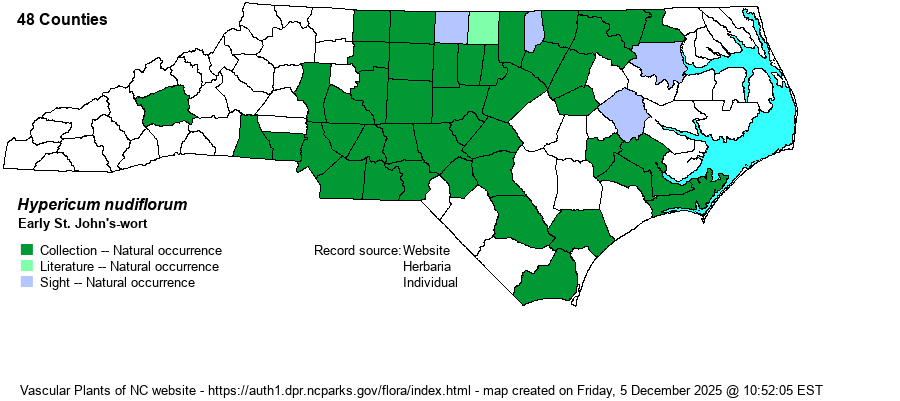| Author | Michaux ex Willdenow | |
| Distribution | Primarily the Piedmont and the extreme upper Coastal Plain, but present at scattered localities over parts of central and the southeastern Coastal Plain, as well as one site in the Mountains. Likely absent in most of the Mountains and in parts of the eastern Coastal Plain, especially near Albemarle and Pamlico sounds.
Surprisingly, this species does not range much farther north than NC, reaching only southern VA and southeastern OK, and then south to the FL Panhandle and eastern TX.
| |
| Abundance | Fairly common to frequent in the central and eastern Piedmont, fairly common in the northwestern Coastal Plain, but rare to uncommon in the central and southern Coastal Plain. It is very rare in the western Piedmont and Mountains. | |
| Habitat | This is a wetland species of shady places, one of the few Hypericum species found in the shade of forest interiors. It grows best in moist/rich bottomland forests, but it also grows along forested stream banks, rarely into swamp islands and edges. | |
| Phenology | Blooms and fruits in June and July. | |
| Identification | This is a medium-height (for a Hypericum) deciduous shrub growing to about 2-3 feet tall, with a moderately branched look (rounded overall shape). It has broadly elliptic to ovate leaves that are sessile at the base and somewhat rounded at the tip, reaching about 1.5-2 inches long. It thus has larger and broader leaves than about all other shrub species in the genus. It has small slightly rounded flower clusters at the tips of branches; the flowers are bright yellow and about 1/2-inch across. As it typical of shrubs growing in full or moderate shade of a bottomland forest, observers often fail to see the flowers because they don’t spend much time in the middle of summer in such wetlands and because such species often do not flower profusely. As such, beginners could overlook a non-blooming plant as Chinese Privet (Ligustrum sinense) or Coralberry (Symphoricarpos orbiculatus). | |
| Taxonomic Comments | None
| |
| Other Common Name(s) | Naked-flowered St. John’s-wort | |
| State Rank | S4 [S5] | |
| Global Rank | G5 | |
| State Status | | |
| US Status | | |
| USACE-agcp | FACW link |
| USACE-emp | FACW link |

